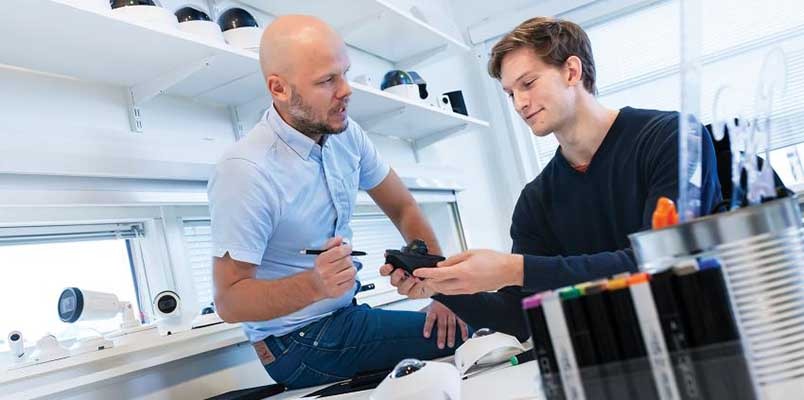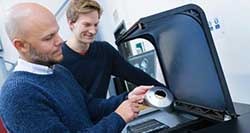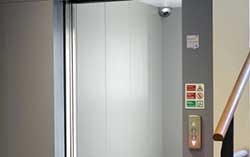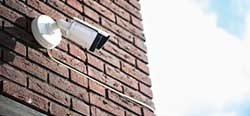
We live in an age filled with technological developments. For some of us, it seems like yesterday that VHS was still a thing, while the younger generations can’t remember a world without touch screens. It’s an exciting period for humanity, filled with stimuli and drive to explore, to invent, to improve. However, when the possibilities are so many, the question becomes where to start and what to give priority to.
At Axis, product management, the department involved in the ordering of new products, has close contact with Axis Sales Regions, where product analysts collect info and data from their own colleagues and the market. Feedback from distributors, installers, partners and system integrators are all taken into account.
We have interviewed a bunch of our experts, who will guide you into the development of a new product design, from the first input to the actual birth.
How do the different teams work together to design a Product?

Jonas Sjögren: When it comes to our Industrial Design process and the way we work in the daily pipeline projects, it differs widely. A part of the projects that, for several reasons, requires more innovation and creativity often starts with a brief coming to us from a Product Manager, with some initial ideas or sometimes just a problem that needs a solution. In these cases, we apply more of a design thinking approach, with more activities related to costumers, user scenarios and so forth. We try to explore many possibilities with different parallel design concepts, quickly made to prototypes. It is quite easy nowadays with our in-house 3D printers and a well-equipped workshop. We try to engage R&D early on to get leverage and to get all the technical considerations into the mix. This also make the prototype manufacturing and the different versions more detailed and with added relevant tech.
Theodor Wahlgren: Indeed, during the development phase we rely on a lot on prototypes to evaluate the different designs, and this helps speeding up the development. The evaluation and development of different designs is done with the collaboration of the design team, the product owner and the project members. During these meetings lots of new ideas are born and then further evaluated during the next meeting, which can be one or two weeks later. This approach is applied from the early concept phase.
Jonas Sjögren: We have an ID Roadmap, a design strategy implementation document, that help to keep our design consistent, but also to adjust and update it as the generations progress, to keep our design values up to date and, in a way, modern. We need to be agile and efficient and this working method enables that.
What are the most important considerations for the team when designing a new product?
Jonas Sjögren: In general, durability, using sustainable materials or considering multiple applications for the technology are all valid considerations for Industrial Design, even if it differs from various projects. Sometimes the Product Management highlights specific values or considerations and we try to understand the context and reason why, putting extra effort into meeting this request.

Theodor Wahlgren: Take the recently launched AXIS P9106-V Network Camera. The main goal for this product was that we wanted an elegant camera with a discreet design which can fit well into a corner in high-end spaces, such as commercial buildings, elevators and many other environments. However, the camera would be well in reach for vandalization, so it also needs to be very robust and easy to maintain. Since it was a new segment for us, much of the early discussions was about what additional benefits we can give to this kind of customers and how we should package it. We had to evaluate lots of different designs, to make sure that we could deliver an elegant and discreet camera, which in addition needed to ensure that there were no blind spots, so that an entire room or elevator could be seen from the corner.
Other important considerations were to ensure an anti-ligature design, when the camera had to be used in healthcare or interrogations room and delivering a nice finish on the product which could fit well into high-end commercial buildings and elevators. Brushed stainless steel is common in these contexts, so the goal was to achieve this look or at least find a finish which suited this environment well. We evaluated different type of coatings trying to mimic a metallic surface, as well as surface treatments to mimic a brushed steel look. Many of the options looked really good, but in the end the elegant look of brushed stainless steel was the winner. The skin cover is also used to hide the front screws, making the product even more discreet, blending perfectly into its surroundings.
How are products tested in the real world?

Theodor Wahlgren: During development we do a lot of testing. Both with prototypes to verify the concept and with parts from tooling to verify the finished product. The tests are done to simulate things that might happen in the real world. Often, we test the extreme cases to make sure our products can handle a wide variety of environments. Often, we will also have real world testing environments before we deliver the final product.
Have customer demands influenced design the design of a new product?
Peter Rietz: Historically, safety and security, has been the key use-case for our products and solutions, but we recently realized that we can help our partners and customers with many other use-cases. One example is in retail, where we can help optimizing the business by having products and solutions that provide insight in what happens in a store. Information like, how many people come to the store and when? How much sales does this lead to? Can we see effects of a marketing campaign? We also can help enhancing the customer experience by giving notifications to the staff, for example if a queue gets too long of if they need to provide background music.
It starts with trying to understand the challenges and needs of the customers. If you understand those, you are much more likely to develop products and solutions that are relevant to them and that can bring them value.














